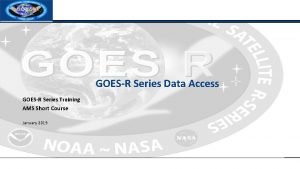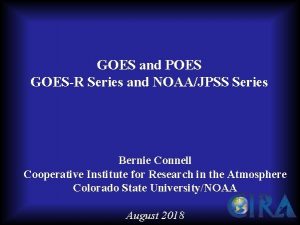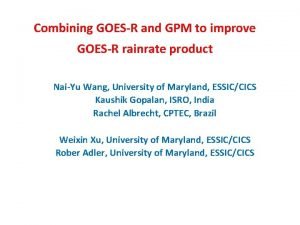The GOESR Series Welcome to GOESR The 1







- Slides: 7

The GOES-R Series: Welcome to GOES-R: The 1. 37 mm “Cirrus” Band Scott Lindstrom UW Madison CIMSS with Kaba Bah, Margaret Mooney, Kathy Strabala, Scott Bachmeier, and more! SHy. Met Introductory Course

ABI: Bands 1 -6 (Visible / Near. IR) ABI Band Wavelength Sub-point pixel Wavelength range (µm) spacing (km) Descriptive Name 1 0. 47 0. 45 - 0. 49 1 “Blue” 2 0. 64 0. 60 - 0. 68 0. 5 “Red” 3 0. 864 0. 847 - 0. 882 1 “Veggie” 4 1. 373 1. 366 - 1. 380 2 “Cirrus” 5 1. 61 1. 59 - 1. 63 1 “Snow/Ice” 6 2. 24 2. 22 -2. 27 2 “Cloud Particle Size” Six visible or near visible bands on ABI (there was only one on heritage imager) Cooperative Institute for Meteorological Satellite Studies University of Wisconsin - Madison

Very strong absorption by water vapor in the “cirrus” band with a very narrow spectral width compared to other visible bands. 0. 47 mm Cooperative Institute for Meteorological Satellite Studies University of Wisconsin - Madison Transmittance 2 0. 64 mm 3 4 5 6 0. 86 mm 1. 38 mm 1. 61 mm 2. 2 mm Transmittance 1

Why use the “Cirrus” Band 2. 0 -km, spatial resolution. Excellent for revealing features such as: Daytime high, thin cirrus under most circumstances. Highly reflecting blowing dust. Can be used in concert with visible imagery to distinguish between low and high clouds. Information from 1. 37 mm can be very helpful in derived products that assess aerosols, clear sky masks, upper level smoke and ash plumes. Cooperative Institute for Meteorological Satellite Studies University of Wisconsin - Madison

The 1. 37 mm can be used to detect airborne dust. Cooperative Institute for Meteorological Satellite Studies University of Wisconsin - Madison

Why use the Cirrus Band 2. 0 -km spatial resolution. Most sensitive to high, very thin cirrus amongst all the ABI bands. Can easily identify light scattering airborne particles such as: High cirrus ice crystals Volcanic ash Sand Haze Dust Information from 1. 37 mm is critical for multiple aerosols, clear sky mask and cloud type products. Cooperative Institute for Meteorological Satellite Studies University of Wisconsin - Madison

Thank you For more information visit www. goes-r. gov -or find your favorite social media link below www. facebook. com/GOESRsatellite www. youtube. com/user/NOAASatellites twitter. com/NOAASatellites www. flickr. com/photos/noaasatellites













